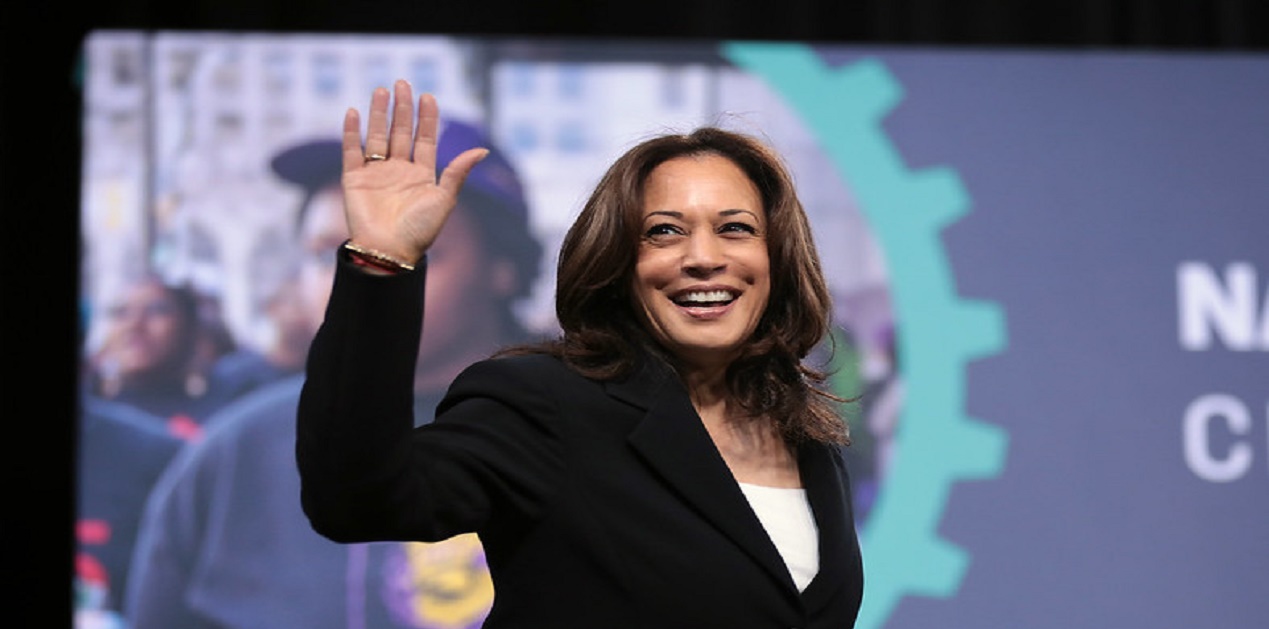Joe Biden has chosen his former critic and rival for Democratic presidential nomination, Kamala Devi Harris, as his running mate for the upcoming Presidential election in November. In his tweet announcing the decision, Biden called Harris “a fearless fighter for the little guy, and one of the country’s finest public servants.” Harris, in turn, tweeted she was “honored to join him as our party’s nominee for Vice President, and do what it takes to make him our Commander-in-Chief.1” Biden and Harris also made their first appearance as running mates in Wilmington, Delaware on August 12. While criticising incumbent President Donald trump over his handling of the coronavirus crisis, both pledged towards better management of the COVID-19 pandemic, economic recovery etc.
The nomination of Harris carries huge symbolic importance given her mixed Jamaican-Indian heritage, making her the first woman of colour to be appointed for such a high-ranking position by either the Democrats or Republicans. The move to have female Vice President of colour had already gained momentum following the police killing of George Floyd and the ensuing nationwide and international protests as part of the black lives matter movement earlier this year. The selection of Harris from a list of several potential candidates also makes the political agenda behind this decision apparent. Daughter of immigrant parents who built their career in the health sector and academia respectively, Kamala Harris as well as her sister continued the success story of her parents’ journey in the US (Maya Harris has been advisor to Hillary Clinton previously). Biden’s remarks regarding the historic decision need also be read in this context - “This morning, little girls woke up across this nation-especially Black and Brown girls who so often may feel overlooked and undervalued in our society -potentially seeing themselves in a new way: As the stuff of Presidents and Vice Presidents”.2 Furthermore, since Biden is expected to run for a single term, the prospects for Harris as the democratic presidential candidate four years later, have widened.
Harris’ bi-racial background, thus, makes her an ideal candidate to appeal to these African-American and Indian-American communities. In addition, Harris’ career background lends her the experience and credibility to deal with domestic reforms, racial discrimination, among others.3 Previously, she has served as San Francisco’s district attorney. She also went on to become the first woman to serve as California’s attorney general. Her track record as the law enforcement official in California contributed to her popularity among the Democrats which ultimately facilitated her election as California's US senator in 2017.4 She has quite a few achievements to her credit but has also faced substantial criticism. Among her most notable feat is her successful brokering of a $25 billion mortgage crisis settlement deal with America’s largest mortgage banks including the Bank of America, JP Morgan Chase, CitiFinancial, Ally Financial, and Wells Fargo. The deal was alleged to have helped thousands of families in California.5
On the other hand, she has been criticised for convicting people for minor offences and overcrowding of prisons (for cheap labour). It has also been reported that despite her current calls for prison reforms, she had herself shied away from intervening in cases involving killings by the police during her tenure as the attorney general of California.6 While she did revise her stance by launching some investigation, her overall approach was seen as moderate. In fact, she is largely seen as too moderate and cautious in her quest for reforms. More importantly, given her ‘unsteady’ performance during her presidential campaign last year, Harris would have to be a lot more articulate in the next three months.7 Her face-off with Mike Pence in the Vice-Presidential debate on October 7 at the University of Utah would be an important test in this context.
Ever since Harris name was announced, there have been numerous attempts to dig out her Indian roots. However, caution must be exercised while showing overenthusiasm over Harris’ Indian linkages. It must be noted that Harris grew up in a ‘black’ neighbourhood at the peak of the Civil rights movement in the US. In addition, Harris attended a historically black university in Washington D.C-Howard university. She also attended a prominent Black sorority known as the ‘Alpha Kappa Alpha’. While she does acknowledge her Indian heritage and has even visited the country on several occasions, Harris has primarily identified herself as a ‘black’ and an ‘American’. As she puts it, “My mother knew she was raising two black daughters," and understood that “her adopted homeland would see Maya and me as black girls.8
The developments in US election campaign, including the appointment of Kamala Harris as Biden’s running mate are a matter of interest for India. However, reading too much intoHarris’ Indian connection and Biden-Harris administration’s implications for Indo-US ties comes across as far-fetched at this juncture since the election is still around three months away. At a time when its relations with China are on a historic low, the future course of the US foreign policy, especially with respect to Beijing would have implications for New Delhi. While the openly anti-China Trump administration may appeal to Indian policymakers, there is ample scope for adaptability with the Biden administration too. At present, the election polls do indicate a tilt in Biden’s favour but if 2016 serves any example, the results could be dramatically turn around as well. Despite the criticism levelled against Trump, his insular policies may actually appeal to residents at a time when the unemployment levels are high in the country. Notwithstanding the ballot outcome, the Indo-US ties carry prospects for cooperation irrespective of the US administration in power.
- https://twitter.com/KamalaHarris/status/1293290197103390721?ref_src=twsrc%5Etfw%7Ctwcamp%5Etweetembed%7Ctwterm%5E1293290197103390721%7Ctwgr%5E&ref_url=https%3A%2F%2Fwww.aljazeera.com%2Fnews%2F2020%2F08%2Fjoe-biden-chooses-kamala-harris-vice-presidential-candidate-200811194032730.html
- https://twitter.com/JoeBiden/status/1293654742820777984
- https://foreignpolicy.com/2020/08/12/joe-biden-kamala-harris-democratic-party-vice-president-running-mate-presidential-elections/
- https://www.bbc.com/news/election-us-2020-53728050
- https://www.vox.com/policy-and-politics/2017/6/16/15808396/kamala-harris-democrat-rising-star-interrupted
- https://www.nytimes.com/2020/08/09/us/politics/kamala-harris-policing.html
- https://www.nytimes.com/2019/07/27/us/politics/kamala-harris-2020-election.html
- https://www.bbc.com/news/election-us-2020-53728050
- https://twitter.com/KamalaHarris/status/1293290197103390721?ref_src=twsrc%5Etfw%7Ctwcamp%5Etweetembed%7Ctwterm%5E1293290197103390721%7Ctwgr%5E&ref_url=https%3A%2F%2Fwww.aljazeera.com%2Fnews%2F2020%2F08%2Fjoe-biden-chooses-kamala-harris-vice-presidential-candidate-200811194032730.html
- https://twitter.com/JoeBiden/status/1293654742820777984
- https://foreignpolicy.com/2020/08/12/joe-biden-kamala-harris-democratic-party-vice-president-running-mate-presidential-elections/
- https://www.bbc.com/news/election-us-2020-53728050
- https://www.vox.com/policy-and-politics/2017/6/16/15808396/kamala-harris-democrat-rising-star-interrupted
- https://www.nytimes.com/2020/08/09/us/politics/kamala-harris-policing.html
- https://www.nytimes.com/2019/07/27/us/politics/kamala-harris-2020-election.html
- https://www.bbc.com/news/election-us-2020-53728050
(The paper is the author’s individual scholastic articulation. The author certifies that the article/paper is original in content, unpublished and it has not been submitted for publication/web upload elsewhere, and that the facts and figures quoted are duly referenced, as needed, and are believed to be correct). (The paper does not necessarily represent the organisational stance... More >>
Image Source: https://www.flickr.com/photos/gageskidmore/40773627633











Post new comment